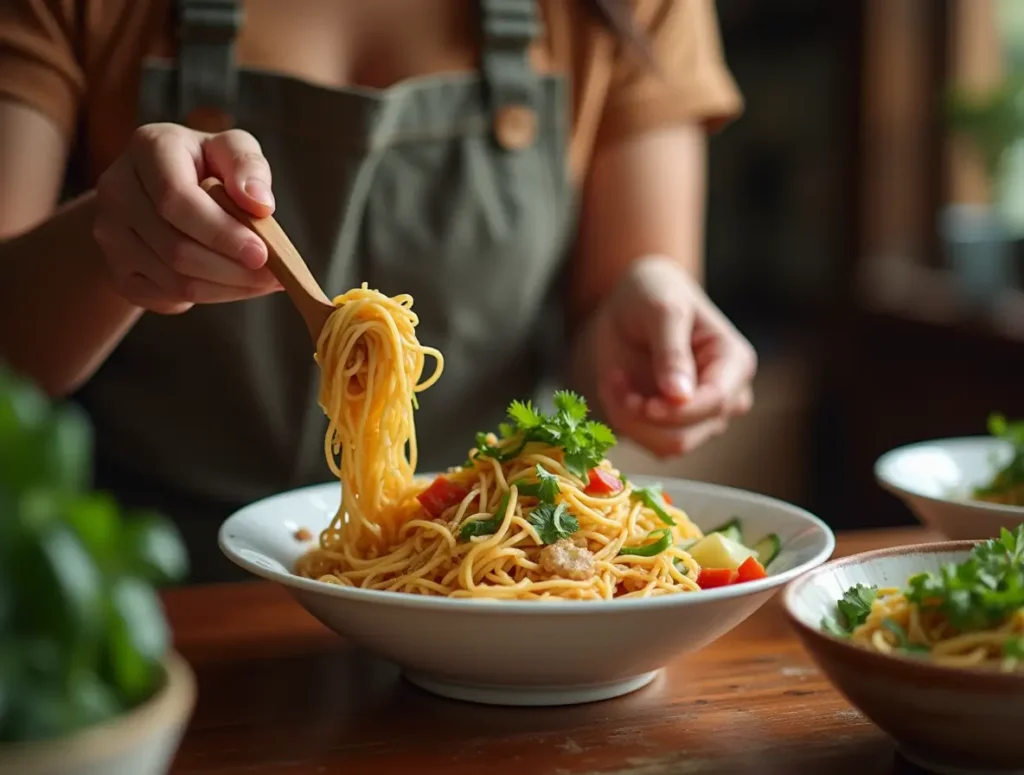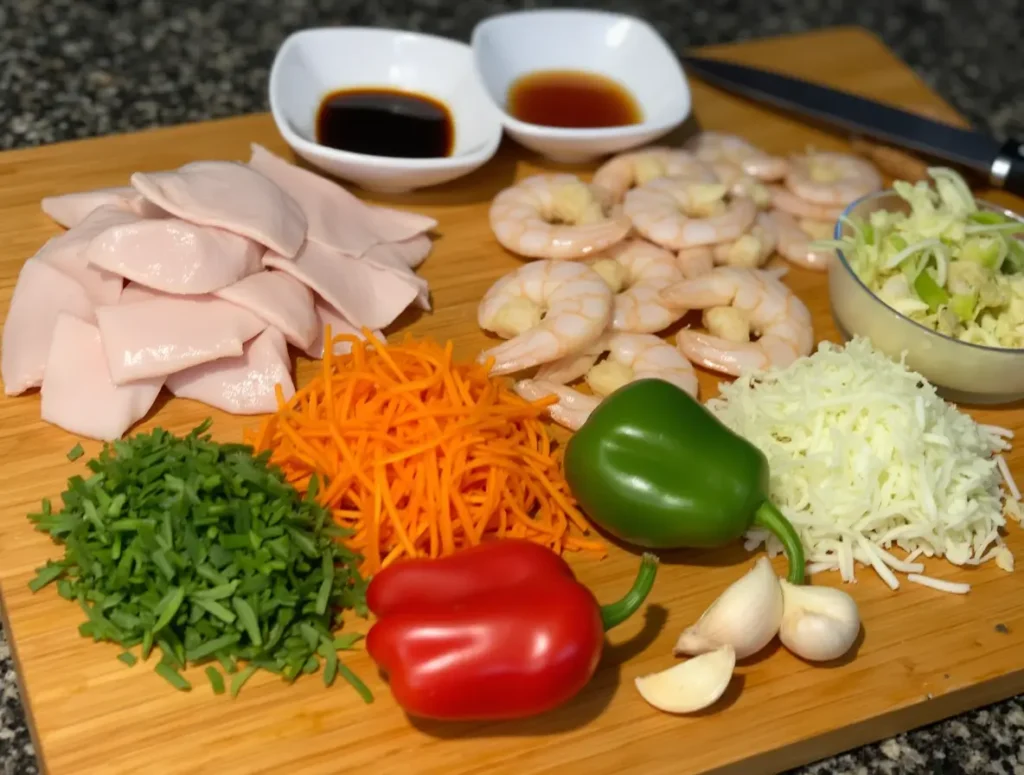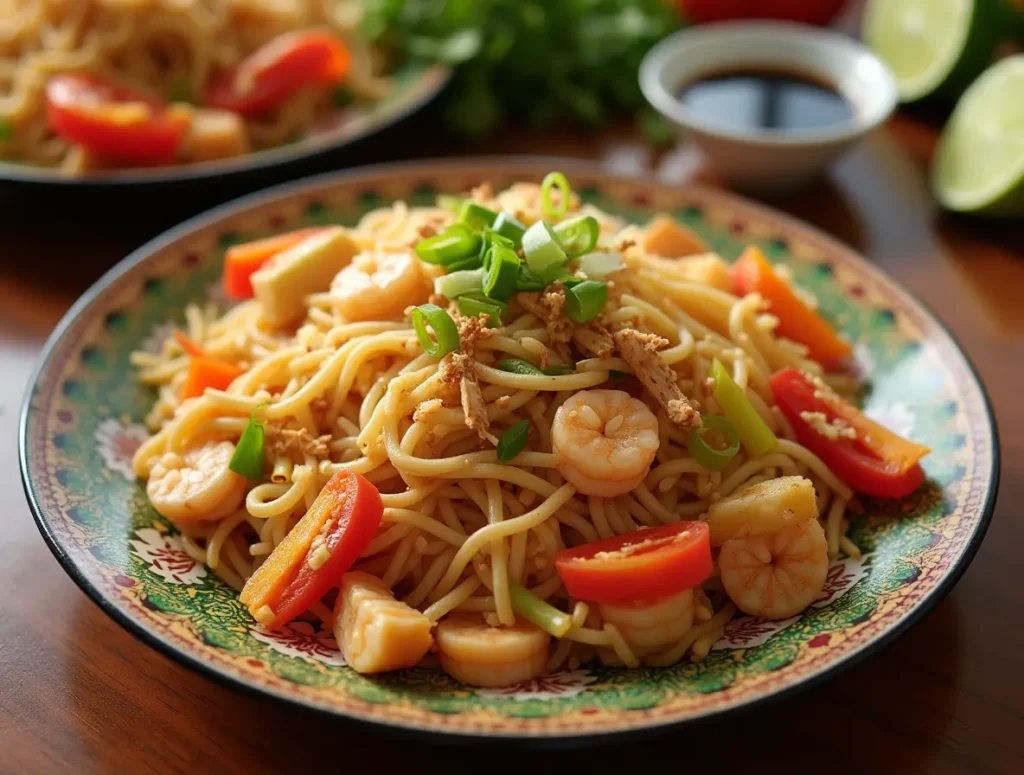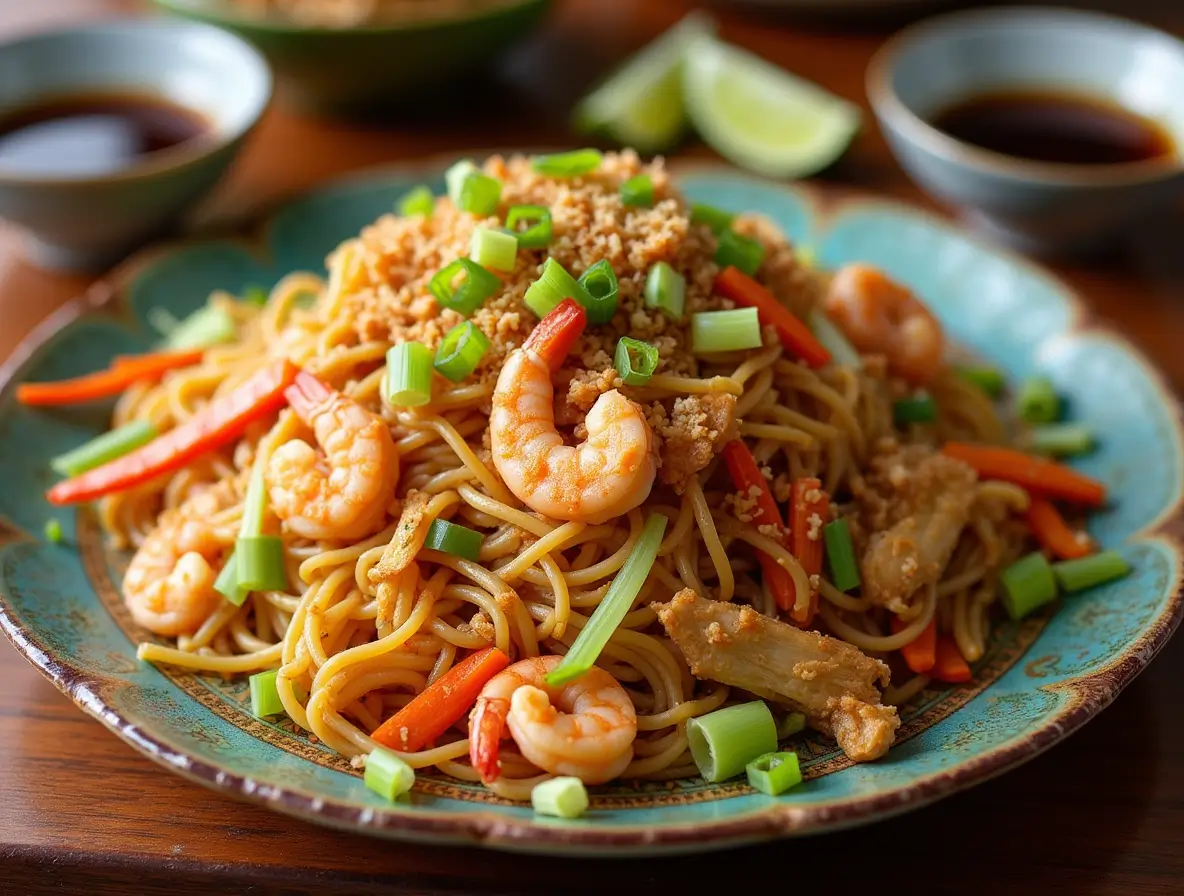A Classic Filipino Noodle Dish
Table of Contents
Introduction
Colorful, savory, and bursting with flavor, Filipino Pancit Bihon brings the vibrant taste of the Philippines straight to your dinner table. These delicate rice noodles, stir-fried with crisp vegetables and savory proteins, create a harmonious blend of textures and tastes that dance across your palate with each delicious bite. Did you know that Pancit is actually served at nearly every Filipino celebration? It’s considered good luck to eat noodles on birthdays and special occasions because the long strands symbolize long life and good health!
What makes Filipino Pancit Bihon truly special is its incredible versatility and simple preparation. Despite its impressive appearance, this dish comes together in under 30 minutes, making it perfect for busy weeknights when you want something satisfying but don’t have hours to spend in the kitchen. The recipe is also incredibly forgiving – you can easily customize it with whatever proteins and vegetables you have on hand.
If you’ve enjoyed my Chicken Adobo recipe with its tangy soy-vinegar profile, you’ll love how Filipino Pancit Bihon offers another authentic taste of Filipino cuisine with its savory, slightly smoky flavor profile enhanced by the aromatic garlic and onions. So grab your wok or large skillet, gather these accessible ingredients, and let’s bring the beloved flavors of the Philippines to your home tonight!
What is Filipino Pancit Bihon?
Ever wondered what happens when Chinese cooking techniques meet Filipino ingredients? You get Filipino Pancit Bihon, the life of every Filipino party! The word “pancit” (pronounced pahn-SIT) comes from the Hokkien phrase “pian e sit,” meaning “something conveniently cooked” – how’s that for truth in advertising? Bihon refers to the specific type of thin rice noodles used, which soak up flavor faster than a gossip soaks up rumors! My Filipino friend’s grandmother insists that serving pancit at celebrations guarantees good luck and longevity – apparently, “the way to a man’s heart is through his stomach” applies to fate as well! With over a dozen regional variations across the Philippines, each family guards their recipe like a treasured heirloom. Why not join this delicious tradition tonight and create your own family pancit legacy?

Why You’ll Love This Filipino Pancit Bihon:
This Filipino Pancit Bihon recipe will quickly become a family favorite for multiple reasons! First and foremost, the star attraction is the perfect balance of flavors and textures. The thin rice noodles absorb the savory chicken broth while maintaining a slightly chewy texture, creating the ideal foundation for the dish. The combination of soy sauce, fish sauce, and a hint of citrus from calamansi or lemon juice creates a depth of flavor that’s simultaneously familiar yet distinctly Filipino.
Making Filipino Pancit Bihon at home is remarkably economical compared to restaurant versions. A generous family-sized portion costs roughly $10-12 to prepare, versus $15-20 for a smaller serving at a Filipino restaurant. Plus, it’s a fantastic way to use up vegetables and leftover proteins hiding in your refrigerator, reducing food waste while creating a delicious meal.
What truly elevates this humble noodle dish is the colorful array of toppings and mix-ins – from crisp-tender vegetables like carrots, cabbage, and snow peas to savory proteins like chicken, pork, and shrimp. The traditional garnishes of sliced green onions, crispy fried garlic, and wedges of calamansi or lemon add brightness and complexity to each bite. If you enjoyed my Kare-Kare recipe, you’ll appreciate how Filipino Pancit Bihon similarly celebrates the beautiful melding of influences in Filipino cuisine. Ready to bring these authentic flavors to your dinner table? Let’s start cooking!
How to Make Filipino Pancit Bihon:
Quick Overview
This Filipino Pancit Bihon recipe is the perfect introduction to Filipino cuisine – quick, flavorful, and incredibly satisfying. The beauty of this dish lies in its brilliant simplicity: thin rice noodles stir-fried with a savory sauce, tender bits of meat, and crisp vegetables. The distinctive flavor comes from the combination of garlic, onions, soy sauce, and chicken broth that infuses every strand of noodle. From start to finish, you’ll need just about 30 minutes, with most of the time spent on simple vegetable prep. The actual cooking happens quickly in a wok or large skillet, making this an ideal weeknight dinner option.
Key Ingredients for Filipino Pancit Bihon:

- 8 oz (227g) rice stick noodles (bihon)
- 3 tablespoons vegetable oil, divided
- 3 cloves garlic, minced
- 1 medium onion, sliced thinly
- 1/2 lb (227g) boneless chicken thighs, thinly sliced (or substitute with pork or shrimp)
- 1/4 lb (113g) Chinese sausage (lap cheong) or sweet Filipino sausage (longganisa), sliced (optional)
- 2 carrots, julienned
- 1 small cabbage, shredded (about 2 cups)
- 1 cup snap peas or snow peas, ends trimmed
- 2 cups chicken broth
- 3 tablespoons soy sauce
- 1 tablespoon oyster sauce
- 1 teaspoon fish sauce (patis)
- 1/4 teaspoon ground black pepper
- 2 green onions, sliced diagonally
- 1 lemon or calamansi, cut into wedges
- 2 tablespoons chopped fresh parsley or cilantro (optional)
Step-by-Step Instructions:
- Prepare the noodles: Place the rice noodles in a large bowl and cover with warm water. Let them soak for about 10-15 minutes until they begin to soften but are still slightly firm (they’ll finish cooking in the pan). Once softened, drain thoroughly and set aside. If the package instructions differ, follow those instead.
- Cook the proteins: Heat 1 tablespoon of oil in a large wok or deep skillet over medium-high heat. Add the sliced chicken (or preferred protein) and Chinese sausage if using. Cook for 3-4 minutes until the chicken is no longer pink and the sausage has rendered some fat. Transfer to a plate and set aside.
- Sauté the aromatics: In the same wok, add another tablespoon of oil if needed. Add the minced garlic and sliced onions. Sauté for 1-2 minutes until fragrant and the onions begin to soften.
- Cook the vegetables: Add the julienned carrots to the wok and stir-fry for 2 minutes. Add the shredded cabbage and snap peas. Cook for another 1-2 minutes until the vegetables are crisp-tender. You want them to retain some crunch.
- Combine the sauce: In a bowl or measuring cup, mix together the chicken broth, soy sauce, oyster sauce, fish sauce, and black pepper.
- Add noodles and sauce: Return the cooked meat to the wok with the vegetables. Add the drained rice noodles and pour the sauce mixture over everything. Using two spatulas or long chopsticks, gently toss and stir everything together, making sure the noodles are evenly coated with the sauce. If the noodles seem too firm, cover the wok and let steam for 2-3 minutes.
- Finish cooking: Continue to stir-fry for about 3-5 minutes, until the noodles have absorbed most of the liquid and are tender but still have a slight chew. If the mixture seems too dry, add a splash more chicken broth. If it’s too wet, cook uncovered a bit longer.
- Garnish and serve: Transfer the pancit to a large serving platter. Sprinkle with sliced green onions and chopped parsley or cilantro if using. Arrange lemon or calamansi wedges around the dish for squeezing over individual portions. Serve immediately while hot.

What to Serve Filipino Pancit Bihon With:
While Filipino Pancit Bihon is a complete meal on its own, it pairs beautifully with several traditional sides and accompaniments:
- Lumpia (Filipino Spring Rolls): These crispy appetizers are the perfect crunchy counterpart to the soft noodles.
- Filipino Barbecue Skewers: Sweet and savory grilled pork skewers complement the savory noodles wonderfully.
- Steamed White Rice: Though it might seem like carb overload, many Filipinos enjoy having a small portion of rice alongside their pancit.
- Pandesal (Filipino Bread Rolls): These slightly sweet dinner rolls are perfect for sopping up any extra sauce.
- Atchara (Pickled Green Papaya): This tangy side dish cuts through the richness of the pancit with its vinegary crunch.
- Fresh Sliced Mango: For dessert, fresh mango provides a sweet, refreshing finish to the meal.
- San Miguel Beer or Calamansi Juice: Either a light lager or the tangy Filipino citrus drink makes an excellent beverage pairing.
Top Tips for Perfecting Filipino Pancit Bihon:
- Don’t overcook the noodles: Soak the rice noodles just until they’re pliable but still firm. They’ll continue cooking in the sauce and can quickly become mushy if pre-soaked too long.
- Prep everything in advance: This dish comes together quickly once you start cooking, so having all ingredients prepped and ready (mise en place) is crucial.
- Layer your flavors: Brown the meat well before removing it, then use that same pan with its flavorful bits to cook the vegetables and noodles.
- Keep the vegetables crisp-tender: Add them in stages based on cooking time, and don’t overcook them. The contrast between the soft noodles and crunchy vegetables is part of what makes pancit special.
- Customize with what you have: Don’t worry if you don’t have exactly the vegetables listed. Pancit is traditionally made with whatever is available, so bell peppers, green beans, celery, or bean sprouts work great too.
- Adjust the sauce: Different brands of rice noodles absorb liquid differently. If the dish seems too dry, add more broth; if too wet, cook a bit longer uncovered.
- Use scissors for serving: Traditional Filipino households often serve pancit with scissors at the table to cut the long noodles into more manageable lengths.
- Add a splash of calamansi or lemon: The citrus brightness cuts through the savory flavors and brings the dish to life.
Storing and Reheating Tips:
Filipino Pancit Bihon stores surprisingly well, though the noodles will continue to absorb liquid as they sit.
For refrigeration, allow the pancit to cool completely before transferring to airtight containers. It will keep well in the refrigerator for 3-4 days. The flavors often develop and meld overnight, making leftovers quite delicious.
To freeze, portion the cooled pancit into freezer-safe containers or freezer bags. Remove as much air as possible before sealing. Frozen pancit will maintain good quality for about 2 months, though the texture of the vegetables may change slightly upon thawing.
When reheating, the best method is in a skillet or wok over medium heat with a splash of chicken broth or water to rehydrate the noodles (about 1-2 tablespoons per cup of pancit). Cover and steam for a few minutes, then stir occasionally until heated through. This method helps revive the texture better than microwaving.
If using a microwave, place a portion in a microwave-safe container with a sprinkle of water, cover loosely, and heat in 30-second intervals, stirring between each until hot.
For meal prep, you can prepare all the components separately (cook the proteins, cut the vegetables, mix the sauce), and store them in the refrigerator for 1-2 days. When ready to eat, just soak the noodles and stir-fry everything together for a fresh-tasting meal in minutes.

Recipe Schema Markup:
- Preparation Time: PT15M
- Cooking Time: PT15M
- Total Time: PT30M
- Type of recipe: Main Course
- Cuisine: Filipino
- Keywords: Filipino Pancit Bihon, rice noodle stir fry, Filipino noodles, celebration noodles, easy Asian noodles, Filipino street food, weeknight dinner
- Recipe Yield: 4-6 servings
- Calories: 320 calories per serving
Pros:
- Quick to prepare – ready in 30 minutes
- Extremely versatile – can use any protein or vegetables
- One-pan meal with minimal cleanup
- Great for using leftover vegetables and proteins
- Naturally gluten-free if using gluten-free soy sauce
- Balanced meal with protein, vegetables, and carbohydrates
- Authentic Filipino flavor with widely available ingredients
Cons:
- Rice noodles can become mushy if oversoaked or overcooked
- Best served immediately, texture changes when stored
- Requires quick, active stir-frying (not a “set it and forget it” recipe)
- Traditional version requires several specialty Asian ingredients
- High in sodium due to soy sauce and other condiments
- May require a very large pan for the full recipe
Recipe Instructions:
- Soak rice noodles in warm water for 10-15 minutes until slightly softened
- Cook chicken and sausage in oil until no longer pink, then set aside
- Sauté garlic and onions in same pan until fragrant
- Add carrots, cabbage, and snap peas, stir-frying until crisp-tender
- Combine sauce ingredients in separate bowl
- Return cooked meat to pan, add drained noodles and sauce
- Stir-fry everything together for 3-5 minutes until noodles are tender and have absorbed sauce
- Garnish with green onions, herbs, and lemon wedges before serving

